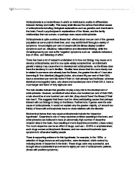Introduction
When we meet an individual for the first time in our lives we begin to evaluate them instantly and immediately form judgments on their character and personality through what we observe by watching them, speaking to them or in some cases hearing prior information about them from third parties.
We use any data that is available at the time to form judgements and these judgements have the tendency to be permanent assumptions.
Asch (1946) proposed that impression formation is the result of gathering together a list of traits associated with a person and using these to produce an impression. Asch conducted a study in which participants were given either warm (happy, fun and positive) or cold (negative, unhappy and pessimistic) words to describe an individual. The participants were then asked to write a few sentences about the individual and what they felt about them.
Results showed that those who were described as warm were described by participants as being happy and generous whereas those who were associated with the word cold were described with the opposite traits than those with the word warm.
Asch found that those who were described as intelligent or skilful were seen as this by third parties. Consequently these findings provided evidence for the halo effect (Feingold 1992)
Psychologists use the term halo effect (Feingold 1992) whereby if a person is described through the use of positive words, he or she will be seen as a positive.
Although Asch’s study found a direct link between pre-information and impression formation, many psychologists oppose his view and argue that Asch’s study lacks realism and therefore is difficult to apply to real life and subsequently lacks ecological validity. This means that Asch’s studies cannot be used to explain occurrences revolving around impression formation in real life.
This is due to the fact there is a large amount of artificiality and therefore results may have been susceptible by demand characteristics exhibited by participants. This is because the words cold and warm may be associated with something within a different dimension and not central traits such as warm meaning happy and vice versa.
Harold Kelley improved upon Asch’s research and created the co-variation theory, whereby Kelley argued we gain our information and make judgements of people from information gained from two sources of data. One source being the information we already have learnt from others about an individual (e.g. Pre-Information).
Kelley devised an experiment in support of his theory by arranging for a group of college students to be taught by an unknown teacher (they had never met the teacher in question).
Prior to the college students meeting their new teacher they were told that they would be asked a few short questions on what effects new teachers have on classes. Further to this, students were given a short snippet about the new teacher.
The short snippets of biographical data were the same except half of the snippets distributed showed the new teacher in a negative light while the other half showed the new teacher in a positive light.
Overall, the results showed that those students who were given positive information about the new teacher described the teacher as having positive merits such as being good natured. While it the other half of students (those who were given negative information about the new teacher) characterised the new teacher of having negative intrinsic worth e.g. mean.
Kelley’s research and findings supported the claims of the Halo effect (as suggested by Feingold).
Outline of Aims and My Hypothesis
The research carried out by Asch and Kelley have contributed significantly to my aims and hypothesis.
The main goal of my study is to replicate the research conducted by Kelley in 1950. However, the design of the experiment will be adjusted to create a modern equivalent.
My hypothesis is pre-information will have a direct affect on impression formation. This hypothesis is directional as studies such as this have already been completed.
I intend to conduct a study to support Asch’s theory. This study will be loosely based on Asch’s study however it will not be a total replica.
Contrary to the evidence that supports Asch’s theory our study may suffer from cultural differences e.g. if we show participants pictures of people from different cultures e.g. Chinese, Indian or Hispanic they may already have pre-existing ideologies and therefore these may influence results in a negative way.






